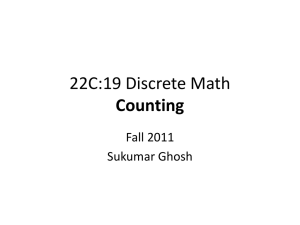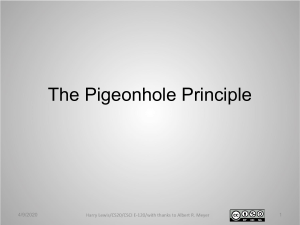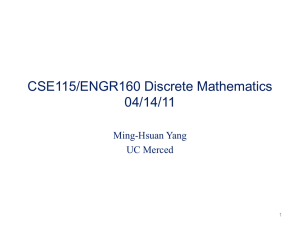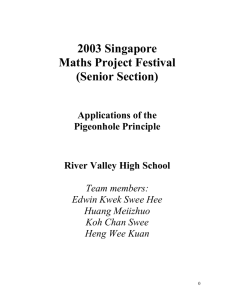What is a Game? - The University of Hong Kong
advertisement
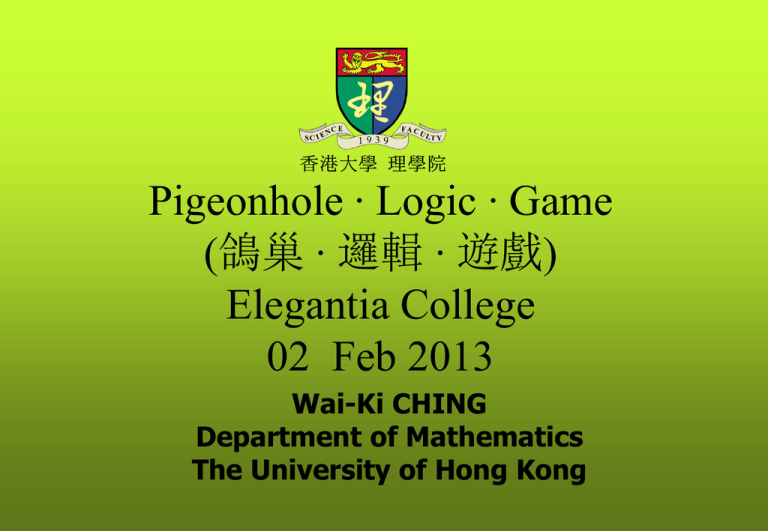
Pigeonhole ∙ Logic ∙ Game
(鴿巢 ∙ 邏輯 ∙ 遊戲)
Elegantia College
02 Feb 2013
Wai-Ki CHING
Department of Mathematics
The University of Hong Kong
Pigeonhole Principle (鴿巢原理)
If 7 pigeons are to live in 6 boxes (holes), then there is at
least one box containing two or more pigeons (如果7隻鴿子
住在6個籠裡,至少有一個籠包含兩隻或更多的鴿子).
Dirichlet (狄里克利)
The first statement of the
Pigeonhole
Principle
is
believed to have been made
by
the
German
Mathematician(德國數學家)
Dirichlet (狄里克利) in 1834
under
the
name
Schubfachprinzip
(drawer
principle).
Dirichlet (狄里克利)
• Dirichlet(1805~1859)德國數學家,
生於現德國 Duren(當時屬法國)。他
是解析數論 (Analytic Number Theory)
的奠基者,也是現代函數 (Functions) 觀
念的定義者。
• Dirichlet 人緣不錯,勤奮寡言,不修邊
幅又健忘,卻是一個觀念清晰的好老師
。(He is a nice and hard working teacher)
Continue
• Dirichlet 於1825年證明(prove)費瑪最後定理
(Fermat’s Last Theorem) (when) n=5 情況而得
盛名 , 後因心臟病發(heart attack)於瑞士,
最後病逝於哥廷根。
• 費瑪最後定理: Xn + Yn =Zn , n=3,4,5,…,
• n=2:
32 + 42 =52 .
Taken from: http://episte.math.ntu.edu.tw/people/p_dirichlet/
Pigeonhole Principle (鴿巢原理)
If we put n+1 balls into n boxes, then at
least one box must contain two or more
balls.
將 n+1 個球放入 n 個盒子內, 最小有一
個盒子藏有2個或以上的球。
Proof by Contradiction (反證法)
• We want to prove that ‘at least one box must
contain two or more balls’ by ‘Proof by
Contradiction’.
• Assume that the statement is wrong (假設上面的
事情是錯誤) then all the n boxes contains 1 or 0
ball. Therefore the total number of balls is less
than or equal to n. This is a contradiction (矛盾).
The contradiction is due to our assumption that
the ‘statement is wrong’.
• We conclude that the statement must be true.
Examples (例子)
• For any 368 people, at least two of them
must have the same birthday(對於任何368
人,其中至少有兩人個有相同的生日).
• There are at least two people in the world
having same number of hair. (在世界上至
少有兩個人具有相同數目的頭髮).
• At least two of you in this class born in the
same month (你們至少有兩個人出生於同
月) .
Exercise 1 (練習 1)
• There are 10 married couples. How many
of the 20 people must be selected in order
to guarantee that one has selected a
married couple (有10對已婚夫婦,其中我
們必須選擇多少人,以保證能選定至少
一對夫婦)?
• Answer: 11
Mark Six (六合彩)
Mark Six is a popular lottery
game in Hong Kong. Similar
lottery game can be found all
over the world. There are 49
balls (number 1 to 49) in the urn.
Six balls are first drawn without
replacement. The 7th ball is then
drawn as the special number.
The following is some ten draws of the Mark Six Lottery
in reverse order.
Something to Think About (想一想)
• One observes that at least 2 drawn
numbers having the same first digit in all
the cases (我們觀察到至少有2個數字的
十位是相同的) (we assume that 1=01,
2=02, 3=03, ….,).
• Do you think there is something wrong
with the machine (你認為是否機器出故
障嗎)?
Explanation (解釋)
• There are 6 numbers to be drawn.
• For each number, the first digit (十位) can be
{0,1,2,3,4}. There are only 5 choices (五種選擇).
• This is equivalent to put 6 balls into 5 boxes with
labels: 0,1,2,3,4. Therefore at least one of the
boxes contains 2 or more balls.
Exercise 2 (練習 2)
Is it possible to fill in the following 5-by-5 square
with either 0,1 or -1 such that the row sums,
column sums and the two diagonal sums are all
distinct (行,列和對角和 是完全不同的)?
0
1
0
-1
1
1
1
0
1
-1
-1
0
0
1
0
1
0
0
1
1
Solution (解答)
The maximum sum (最大的總和) is 5
The minimum sum (最小的總和) is -5
{-5,-4,-3,-2,-1,0,1,2,3,4,5}
There are 5+5+1=11 different possible sums (不同
可能的和).
But there are 5 rows, 5 columns and 2 diagonal
sums, a total of 12 choices to be filled in by only 11
numbers. By Pigeonhole Principle we conclude that
the 12 sums cannot be distinct.
Pigeonhole Principle : Strong Form
(鴿巢原理:加強版)
If we put (k*n+1) balls in n boxes, then
at least one box must contain k+1 or
more balls.
將 (k*n+1) 個球放入 n 個盒子內, 最小有
一個盒子藏有k+1個或以上的球。
Proof (證明)
• We want to prove that at least one box must
contain k+1 or more balls.
• Assume that the statement above is wrong
then all the n boxes contains k or less balls.
Therefore the total number of balls is less
than or equal to n*k. This is a contradiction.
The contradiction is due to the assumption
that ‘the statement is wrong’.
• We conclude that the statement must be true.
Exercise 3 (練習 3)
• There are 90 people in a hall. Some of them
know each other, some are not (90人在一個大
廳。其中有些相互認識,有些則不是).
Prove that there are at least two persons who
know the same number of people in the hall
(證明至少有兩個人, 他們認識相同數量的人).
• What should be the holes and pigeons? How
many holes are there?
Solution (解答)
• If there is a person in the hall who does not know
any other people, then each of the other persons in
the hall may know either 0, or 1, or 2, or 3, ... , or
88 people. Therefore we have 89 holes: 0, 1, ... , 88,
and have to distribute among 90 people.
• Next, assume that every person in the hall know at
least one other person. Again, we have 89 holes: 1,
2, ... , 89 and 90 people.
• Therefore in either case, we can apply the
Pigeonhole Principle to get the conclusion.
C
B
D
A
E
F
How to Play SIM (遊戲規則) ?
• The game board consists of six points in the form of
a hexagon. The points are labeled as A, B, C, D, E, F.
• Two different colored strings are distributed to two
players. The players take turns to join any two points
with their own strings.
• The aim of the game is to force your opponent to
complete a triangle of his color. The points of the
triangle must be three points of the hexagon
A,B,C,D,E,F.
Gustavus J. Simmons
SIM is invented by well-known graph
theorists and cryptographer Gustavus J.
Simmons. Simmons described the game in
his 1969 paper. He is a “Senior Fellow for
National Security Studies” at the Sandia
National Laboratories, Albuquerque (NM),
USA.
http://hkumath.hku.hk/~wkc/MathModel/
Game in Progress (殘局 )
C
B
D
A
E
F
In this game, both Peter (red lines) and Paul (blue lines) have made six
moves. If Peter now chooses DE, then Paul is forced to choose either EF
(and Paul loses by completing triangle BEF and triangle AEF) or CD
(and Paul loses by completing triangle BCD).
A Question You Should Ask (必問題)
After playing this game several times, you may ask
the following question.
Is it possible to have a draw ? (可和否?)
The answer to this question is NO. But why?
We will give a proof by using Pigeonhole Principle.
Proof (證明)
• We assume a draw is possible (all
lines are drawn) and hope to arrive
at a contradiction.
• We choose a point, say A. Then,
there are five lines joining A to the
other points. They are AB, AC, AD,
AE and AF.
• Since we have two different colours,
by the Pigeonhole Principle, at least
3 lines must be in the same colour,
say AB, AC and AD.
• We may assume these three lines are
red.
C
B
D
A
E
F
Continue
• Now, we consider the triangle
BCD.
• If one side of triangle BCD is
red, then we have a red
triangle, otherwise BCD will
be a blue triangle.
• Therefore, either a red or a
blue triangle must exist and it
is impossible to have a draw.
C
B
D
A
E
F
An Example
Continue
Remark : Extension of the Proof
• You can play SIM on a polygon (n vertices)
and there will be no draw if the polygon is
NOT a Triangle, a Square or a Pentagon.
• This means that for n > 5, playing SIM will
result in no draw and the proof is the same
as before. Follow the previous proof (try
and see).
A Triangle (三角形)
A Draw is Possible (和局是可能的)!
A Square (正方形)
A Draw is Possible (和局是可能的)!!
A Pentagon (五角形 )
A Draw is Possible (和局是可能的)!
References
• M. Gardner, Mathematical Games, Scientific American,
February (1973), pp. 108-112
• E. Mead, A Rose, C, Huang, The Game of SIM: A
Winning Strategy for the Second Player, Mathematical
Report No. 58, 1973, McMaster University.
• L.E.Shader, Another Strategy for SIM, Mathematics
Magazine, Vol. 51. No. 1, pp. 60-62, 1978.
• G. J. Simmons, The Game of SIM, Journal of
Recreational Mathematics, 1969.
• Some Mathematical Games are Available at
http://hkumath.hku.hk/~wkc/MathModel/index.php





